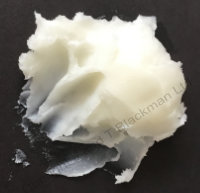 |
Cold Wax Painting Medium |
|
 |
Cold Wax Painting Medium |
|
Techniques used with the Cold Wax Painting Medium
How do you apply Cold Wax?
|
|
Mixing Wax and Oil paint
The large pile of Cold Wax Medium on the left in the image, can easily be coloured with the small glob of oil paint on the right! The amount of oil paint that is added to the Cold Wax Painting Medium is a matter of personal choice. Determined by the painting or application and how it is applied. Spend a little time mixing the Cold Wax Painting Medium and Oil paint to find what consistency and feel you prefer. |
|
A closer look at the Cold Wax Painting Medium with a small amount of Oil paint added. The texture of both wax and oil is clear to see. The wax has modified the oil, not only by volume but it is more translucent, with plenty of 'body'. It's a good practice to move some wax from the initial pile. Then only add a small 'pea sized' blob of oil with the tip of a palette knife. Mix the two together and note the way it mixes and the effect you achieve, adjust accordingly. |
|
|
|
The consistency showing in the above image would be good to use with bristle brushes for stippling the paint onto a surface. Stippling has been used for hundreds of years for adding paint to a surface, the marks, textures and patterns are easy to achieve with practice and are very expressive. Examples of some available marks from three different brushes are shown left, because the wax is mixed with the oil paint the surface is very textured and upraised. Try these marks with different round and flat brushes. |
| Pale blue wax/oil was brushed onto the untreated birch ply, dark paint was knifed on starting thicker on the left. Other colours were also knifed onto the surface. Tools like those shown as Clay Tools and Colour Shapers were used to inscribe the surface of the wax. Some were fast gestured movements, others sharp and angular, others slow squiggles. The veneer of the birch ply showed through, this could be further coloured with thinned wax/oil or a glaze. |
|
|
|
This is a close-up from the painting 'Spume'. Spume means to create or form a mass of froth or foam. This was accomplished with a painting knife. The paper was coloured or 'under painted' with thinned oil mixture which was first brushed onto the surface. A painting knife was then used throughout to apply and mix wax/oil of various tones ending with the almost white mixture, which shows bright against the dark under colour. The effect of the water foam was achieved by, in effect, stippling with the knife. The knife, just like with the brush leaves behind a pattern, often quite random, which gave the moving, 'flying foam' effect. |
| In this example the wax/oil mixture was applied using a painting knife and a thin 'skim' applied to cover the surface of the canvas. The 'tree like' mark made in the middle, going north-south, was applied using a brush. Needs a delicate touch. The lines travelling east-west were made with a blunt blade used to 'plough' the wax/oil without taking it from the surface of the canvas. |
|
|
|
Here a small amount of transparent oil paint has been mixed into the Cold Wax Painting Medium using a small Fitch brush, these are Decorators brushes.
The hair in a Fitch brush is not as tightly packed as an artists Hog for instance, making it easier to move and apply the thick mixture. Also called a 'cutting in' brush, or nooks and crannies brush! The direction of the brush strokes can be used to form patterns and texture on the surface when applying the wax. |
| Knife marks Have some fun! Copyright © Jacqui Blackman 2015 If you see this information anywhere else, then you know it has been plagiarised |
 |
Products | Cold Wax Painting Medium | Cold Wax Solvent
Copyright 2001 - 2025 © Jacqui Blackman. All Rights Reserved
Worldwide.
The information contained herein is the Intellectual Property of
Jacqui Blackman and
J. & T. Blackman Ltd., and is supplied without liability for
errors or omissions.
Zest-it ® and its ![]() logo are Registered Trademarks.
logo are Registered Trademarks.
No part may be reproduced or used except as authorized by
contract or other written permission, unless stated otherwise.
The copyright and the foregoing restriction on reproduction and
use extend to all media in which the information may be embodied.